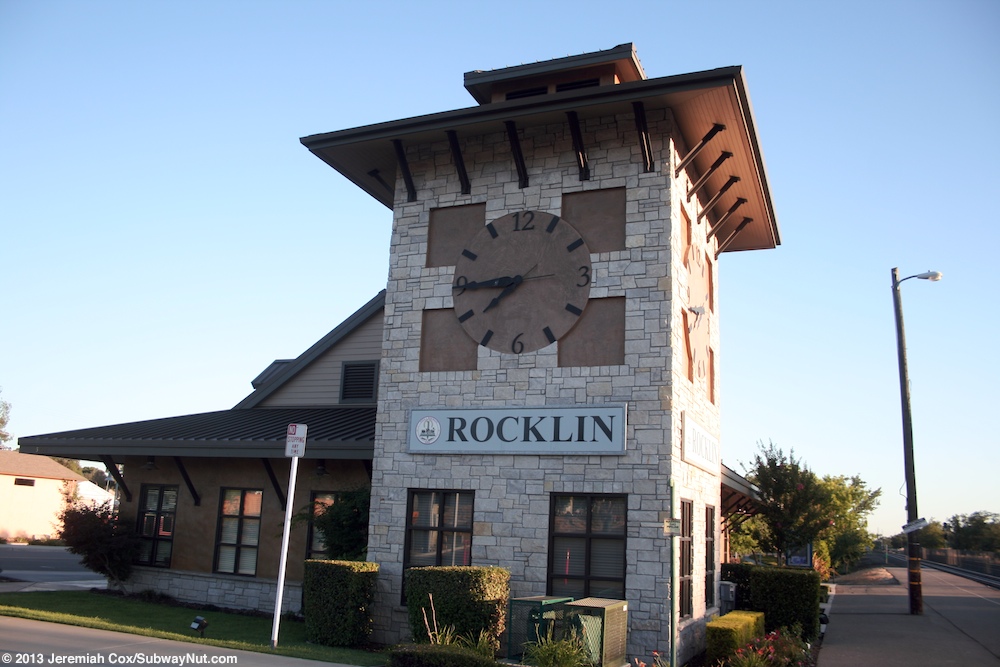Rocklin City
Rocklin City

City of Rocklin
CP broke ground in January 1863 near the current Amtrak station in Rocklin. There were almost no wood ties remaining on the East Coast, so supplies had to be shipped from the East Coast to California, a journey that could take up to eight months due to the 18000 miles involved. The railroads organization allowed it to progress steadily, albeit at a slow pace, such that, by May 1864, it reached a small settlement near Secret Ravine after covering more than twenty miles. There are abundant granite outcroppings in the area that have been mined and used for culverts and tunnels in the mountains. In towns along the railroad route, including Rocklin, many Irish immigrants settled.
A few years before Victorian Era technology was exploding, the CP was constructed. A high-altitude railroad infrastructure was built predominantly by hand, using picks and shovels also aided by nitroglycerine, in the Sierra Nevada. These workers were mostly immigrants from south China, and they often handled dangerous jobs. After crossing the state line into Nevada, CP crews made the connection with Union Pacific a year later.
The village by the tracks, which was generally known as Secret Ravine, received its name Rocklin following its appearance on an 1864 schedule. Rock probably refers to the abundance of granite in the area, although its origins have never been definitively established. CP's right-of-way allowed James Bolton to divide his farm in order to foster the growth of a downtown. As a result of the CP's completion of a roundhouse at Rocklin the following year, new settlers from all over the country sought employment around the city. On the opposite side of the tracks from the present depot, it was home to a roundtable and 25 stalls. Nearby was a large wood shed.
It was chosen for the roundhouse location since Rocklin marks the point where the right-of-way starts to become steep as it heads into the Sierra Nevada. It was necessary to add helper locomotives to the trains in order to surpass the approximately 90 miles of the range's summit. As each locomotive was powered by wood, the forest in the surrounding countryside also played a role in where the roundhouse was built. CP employed approximately 300 residents by the end of the century, with half servicing up to 1200 locomotives every month. Around the roundhouse, storefronts, restaurants, and hotels were built, and Granite Road (now Rocklin Road) and the tracks became the center of town.
A passenger depot stood in the approximate location of the current station in the late 1860s, but it was destroyed by fire in 1891. Rebuilt in the same way as the roundhouse, which had burned in 1873. The structure was a simple wooden rectangle with a gabled roof. Its eaves were overhanging with curving brackets, protecting passengers from rain and snow. A station master could monitor the line's traffic from a bay with windows along the trackside. On the opposite side of the tracks was a freight house looking very much like the depot, with a wooden platform on which crates and parcels were loaded onto carts and wheeled directly from the boxcars.
Railways encouraged local industries to develop. As a result of rocklins granite's hardness and fine grain, it was often shipped by rail car to California's growing coastal cities. The U.S. Mint and the Palace Hotel in San Francisco were also built using Rocklin granite. More than a dozen quarries were operating around 1900, ranging in scale but employing hundreds of workers. Each of these communities left its mark on the town, with many Finnish, Russian, and Italian laborers.
It wasn't long before irrigated agriculture became prevalent in Rocklin, Loomis, Penryn, and Newcastle, as well as nearby towns. Located on western slopes, the west-sloping hills kept temperatures moderate, which was ideal for growing peaches, plums, grapes, pears, and berries. Approximately 221 million pounds of fresh fruit were shipped via boxcar to cities throughout the country around 1910. Throughout his Spring Valley Ranch, which has grown to over 27 thousand acres, J.P. Whitney experimented with a wide variety of crops. In a time when fresh fruits were hard to come by, raisins were a prized treat; he was one of the first producers of Muscat grapes, which dried to make raisins. A specialist in hardy navel oranges, Whitney also pioneered the cultivation of citrus trees in northern California. As a result of the conditions in the foothills, they often ripened 6-8 weeks earlier than those in the southern part of the state, and they were among the first to be shipped to the East Coast because of these climatic conditions.
Social Cali Digital Marketing Company
Address: 2237 Apple Grey Ct, Rocklin, CA 95765
Phone: (916) 796-1220
Website: https://www.socialcali.com/rocklin-digital-marketing-agency
